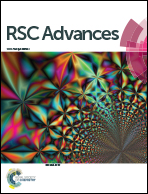Screening donor groups of organic dyes for dye-sensitized solar cells†
Abstract
Based on an experimentally synthesized dye D5 (also named d01 in this work), we designed and screened a series of dyes d02–d06 with different electron donors, such as diphenyl ethylene benzene, phenothiazine and perylene and d07–d12, by modifying the donor of d06 using different electron-donating groups. The results indicate that the donor in d12 is a promising electron donor. Therefore, we further designed six novel D–π–A structures of BUCT7–BUCT12 by using the electron donor in d12 as a donor, any two of 3,4-ethylenedioxy thiophene (EDOT), thienothiophene and dithieno[3,2-b:2′,3′-d] thiophene (s-DTT) groups as a π-conjugated bridge, and dicyanovinyl carboxylic acid and dicyanovinyl sulfonic acid as the acceptors. The calculated results indicate that BUCT7–BUCT12 dyes show smaller HOMO–LUMO energy gaps, higher molar extinction coefficients and obvious redshifts compared to the experimentally synthesized d01 dye. In particular, the newly designed BUCT8 dye not only exhibits a redshift of 134 nm and a higher molar extinction coefficient with an increment of 74.1% compared to d01 dye, but also has an extremely broad absorption spectrum covering the entire visible range up to the near-IR region of 1000 nm. In addition, we also found that the dyes with dicyanovinyl sulfonic acid as the electron acceptor are superior to the ones with dicyanovinyl carboxylic acid.


 Please wait while we load your content...
Please wait while we load your content...